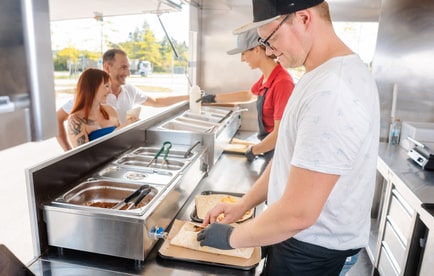Anyone working in the food production, manufacturing or service fields, as well as the fields that support them, knows how important it is to follow sanitary guidelines completely and consistently. Of course, the scope of this is immense as it includes a laundry list of best practices, regulations, and certifications. While the precautions that are attached to sanitation and safety within the food industry may seem endless, today we will be discussing one primary focal area for food production and manufacturing safety: the food contact surface.

In the book, Innovation and Future Trends in Food Manufacturing and Supply Chain Technologies, food contact surfaces are defined as “all surfaces that may come into contact with food products during production, processing, and packaging.”
The FDA (U.S. Food and Drug Administration) further defines food contact surfaces as “surfaces that contact human food and those surfaces from which drainage onto the food or onto surfaces that contact the food ordinarily occurs during the normal course of operations.” Included in this definition are utensils, as well as equipment surfaces.
These surfaces can be furnished from a range of food-safe and/or food-grade materials, such as stainless steel, plastic, wood, rubber, glass, or ceramics.
Although these materials may vary, all must be strong enough to stand up to frequent cleanings with harsh, acidic cleansers. The food contact surface cannot buckle under the strain of various elements, particularly high temperatures. Typically, food contact surfaces require ultra-smooth surface finishes that are devoid of pores or crevices that might attract fallen food particles, lending to bacterial growth.
As highlighted above, food contact surfaces come along with a host of requirements, namely in the way of ultra-smooth surface finishes. Let’s consider one of the most popular food contact surfaces, stainless steel, for instance. If a food contact surface is furnished out of stainless steel, it must be listed and tested as ‘food-grade’, a variety that only accounts for three stainless steel variations out of roughly 150; these variants are known as 304, 316, and 430.
While 304, 316, and 430 do possess some key differences, specifically in terms of nickel and chromium content, all are rust-resistant, fire-resistant, and free of crevices and cracks. These stainless steel options are also considered ‘food-grade,’ which means that they will not be compromised when used normally.
Looking at this example, you can see that a material must meet several criteria in order to be deemed a safe ‘food contact surface,’ including:
Perhaps unsurprisingly, someone using a commercial food contact surface cannot simply deem any surface as being ‘safe for food contact’; instead, the surfaces (and the products and equipment on which they’re used) must meet official standards and/or hold specific certifications. These are outlined by the FDA and are as follows.
All food contact materials (including surfaces) must be covered by at least one of the following:

Because food contact surfaces come with plenty of regulations and stipulations attached, it’s no surprise that food producers, manufacturers, facilities, and handlers alike take food contact surface best practices seriously.
The FDA has made it the requirement of the manufacturer of a food contact surface product to guarantee that the material and fabrication follows the necessary standards. Looking back at the stainless steel example: if a manufacturer is making stainless steel food caddies that are marketed to restaurants for kitchen food prep, it is the manufacturer’s responsibility to ensure that it has undergone the essential testing/and or certification.
Conversely, the buyer of the product may choose to request a letter of guaranty from the manufacturer, certifying that a particular product is acceptable for the intended food-contact use. If the buyer or the manufacturer is concerned about the efficacy of a product’s claims, they can always consult the FDA’s Ingredients, Additives, GRAS & Packaging Guidance Documents & Regulatory Information. In addition to sharing general information about food contact surfaces, the document also supplies food contact notifications and reports on any and all changing guidelines related to the manufacturing or use of the materials.
The topic of food contact surface is a varied one and greatly depends on specific uses, specialized materials, and manufacturing practices. To ensure that you are following the appropriate standards and best practices that apply to you and your products, be sure to follow the guidelines stipulated by industry oversight and regulatory agencies.
No related posts.
Our sales engineers are experts in automatic asset tracking, tagging and identification,a nd can answer all your questions. Get in touch now.
Lets Talk ›